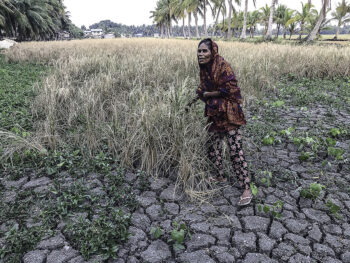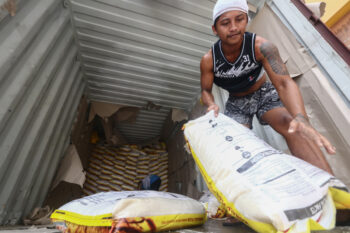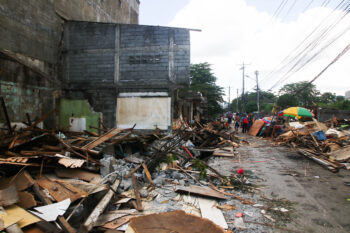
1st of 18 parts
(This is a revised version of the book “KALINAW MINDANAW: The Story of the GRP-MNLF Peace Process, 1975-1996” published in 2000)
This book is dedicated:
To the children of Mindanaw for whose sake, I said,
I must fight for freedom with war.
This is what I have learned from life:
the only way to peace is peace, not war;
the only way to freedom is inner peace.
The first question: Why have “Kalinaw Mindanaw” in the title of the book?
Because, to me, it means “Peace Mindanaw.”
It reflects what we, the Mindanawons, deeply wish for ourselves.
It is also an emphatic encouragement to take the path of peace in resolving our differences.
Peace is its own value.
No less than Article II, Sec. 2 of the 1987 Constitution says in part: “The Philippines renounces war as an instrument of national policy.” This may have been said in relation to settlement of conflicts with other nations, but this applies even more so in the settlement of conflicts among ourselves within our own nation.
Unknown to many, linaw is a word common among Mindanawons, specifically, among the Tausug, Manobo, the Visayans and Tagalogs, to name a few, and the deeper meaning is peace, as is evoked by the inner tranquility of the deep clear water of a lake.
The local word for lake is ranaw or danaw and is shared among the Meranao, the Maguindanao, the Subanen and the Manobo.
Thus, to wish peace for any part of Mindanaw is to desire peace for the rest of the region. I use w instead of o in Mindanaw to emphasize the indigenous character of the name.
But why Mindanaw?
Because the peace of one is the peace of the other.
I am aware that the armed conflict between the government and the MNLF was confined to only certain portions of Mindanaw and the Sulu Archipelago (and the same thing may be said of the AFP-MILF confrontation), never the whole of Mindanaw itself.
Yet, for us the Mindanawons, there is no denying the intimate interconnection of fundamental interests among the three major segments of the entire Mindanao population, the Lumads, the Moros and the Christian Settlers.
Showing the major elements of interconnection is one of the things I have tried to do in this book.
In order to establish new relationships among the tri-people of Mindanaw, we need to see each other in a new light, look more closely at what we have in common and learn to live with our diversity.
This is the only way we can move forward as one. The government can only do so much; the rest is something we need to do ourselves.
The biggest dilemma I had while doing research for this book was whether or not to interview the MNLF (Moro National Liberation Front) leaders, to provide a balanced presentation, as researchers say.
When it was time to interview them, as originally planned, I decided not to.
Not that I am not familiar with their views. I am, quite well, I believe, because I have been keeping tab of statements, both official and informal, written and unwritten, made by MNLF leaders and members in a variety of occasions since 1974 and I enjoyed my associations with many of them (some were my students, in fact).
What I know has convinced me that they have created a significant dent in both Mindanaw and Philippine history; that their story must be told as their story in a separate volume — not by me because I am not Muslim but by a Muslim, better still, a Muslim MNLF like themselves; that to interview them for this book and present them merely as the other side to a story seemed all too unfair.
Also, I have to admit a basic inadequacy within me — there are numerous insights and dynamics within the MNLF and the Bangsamoro which I cannot claim to comprehend.
I had included the implementation of the Peace Agreement in my original outline but somewhere along the way Fr. Eliseo Mercado, OMI, beat me to it by coming out with his book, Southern Philippines Question, on exactly this subject in June 1999. No non-MNLF can write about the topic better than he does. I should thank him for sparing me the trouble.
Just as I was finishing the last two chapters of this book intense fighting broke out between the AFP (Armed Forces of the Philippines) and the MILF (Moro Islamic Liberation Front) in mid-March (2000) in Kauswagan, Lanao del Norte.
Following President Estrada’s declaration of an all-out war against the MILF a week after later, the war went in full swing and before long all the MILF camps, including Camp Abubakar, the rebel’s main camp, have been overrun. At this point, when the resumption of the shattered peace GRP-MILF negotiations seems so remote, I cannot help but ask myself:
Of what use is this book?
It was a depressing thought.
But a few days later, after sleeping over my depression, I realized that the ongoing war between the AFP and the MILF accentuates the very reason why this book was written.
I want to tell the world that the path of peace is not only desirable, it is in fact very doable and costs much less in lives and money.
(The government spent Php 18 million a day during about four months of fighting the MILF, the four year negotiation with the MNLF cost the government less than Php 60 million.)
What does it take to follow the path of peace?
The belief in the sacredness of human life and the invaluability of human dignity.
The belief that peace can only be built with peace.
My deep acknowledgement of thanks to all those who helped with, direct and indirect support, during the one-year sabbatical leave at MSU-Iligan Institute of Technology:
- Billy de la Rosa, Executive Director of AFRIM (Alternate Forum for Research in Mindanao), with whom I signed a Senior Research Fellowship for one year. He provided the funds I needed to do research and writing, until the book was completed. AFRIM published it.
- Aside from my years of accumulated materials and related documents, I also had excellent sessions with wonderful characters who shared their time and wisdom. My four-month correspondence with Dr. Cesar Majul in California was both an excellent lesson in historiography and in Moro history itself. My discussions with Congressmen Eduardo Ermita, Nur Jaafar, Simeon Datumanong, National Security Adviser Alexander Aguirre, former Executive Secretary Alejandro Melchor and former ARMM Governor Lininding Pangandaman — all the exchanges revealed details I knew nothing about earlier. Manuel Yan, our Chair of the Government Peace Negotiation, talked about his own feelings throughout the negotiations, especially at the most crucial points of the talks.
- To the readers and editor who painstakingly went through the draft of this book: Dr. Jamail Kamlian, Prof. Geoffrey Salgado, Fr. Eliseo Mercado, OMI, Carol Arguillas, Marilen Abesamis, Edvilla Talaroc, and Don Pagusara.
- Those who processed and approved my sabbatical leave, namely, Prof. Manolita Olores, the History Department Chair, Evelyn Jamboy who was our dean, Dr. Jimmy Balacuit, the head of Research and Extension Service, Prof. Marcelo Salazar, the Vice Chancellor for Academic Affairs, and Dr. Camar Umpa, Chancellor. At the moment, only Prof. Olores has remained in the Institute.
- My own unconditional pagmamahal to Bebot and Ponpon who have sustained my life and spirit with the same unconditional gugma.
(MindaViews is the opinion section of MindaNews. A peace specialist, Rudy Buhay Rodil is an active Mindanao historian and peace advocate)
TOMORROW: Chapter 1. Why the Impulse to Negotiate?







